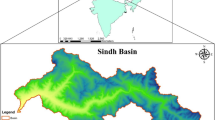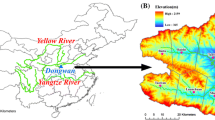Abstract
The complex topology of river networks and the numerous factors influencing streamflow make it challenging to forecast streamflow in large river basins. Improving the accuracy of streamflow forecasting in these basins is of great importance for water resource planning and management. In this paper, considering the spatial variability of impacts of human activities on streamflow, a streamflow forecasting method with a hybrid physical process-mathematical statistic is proposed to obtain better results by realizing the complementary advantages of conventional methods and the streamflow into Hongze Lake in China is forecasted by the proposed method. Firstly, the physical process-based Soil and Water Assessment Tool (SWAT) is used to forecast the streamflow of tributaries with few water storage projects such as reservoirs in the catchment area. Secondly, considering the correlation between mainstream streamflow and tributaries streamflow as well as the correlation between mainstream streamflow and its previous streamflow, streamflow forecasting models based on the vine copula function are constructed to forecast the mainstream streamflow and its confidence intervals, where there are many water storage projects in the catchment area. Then, the total streamflow into Hongze Lake and its confidence intervals are obtained by coupling the outputs of the above two parts. Finally, statistical indicators are chosen to evaluate the forecasting effects in terms of the credibility of deterministic forecasting as well as the reliability and acuity of probabilistic forecasting. The results demonstrate that the proposed method outperforms existing SWAT and long and short-term memory (LSTM) neural network methods in terms of forecasting performance. Consequently, it presents an effective alternative for addressing complex hydrological forecasting tasks in large river basins.














Similar content being viewed by others
Data availability
All data used during the study are available from the first author by request.
Code availability
Codes used during the study are available from the first author by request.
References
(2008) The Concise Encyclopedia of Statistics, pp. 278–281, Springer, New York https://doi.org/10.1007/978-0-387-32833-1_211
Abbott MB, Bathurst JC, Cunge JA, O’Connell PE, Rasmussen J (1986) An introduction to the European hydrological system-systeme Hydrologique Europeen, “SHE”, 1: history and philosophy of a physically-based, distributed modelling system. J Hydrol 87(1–2):45–59. https://doi.org/10.1016/0022-1694(86)90114-9
Arnold JG, Allen PM, Bernhardt G (1993) A comprehensive surface-groundwater flow model. J Hydrol 142(1–4):47–69. https://doi.org/10.1016/0022-1694(93)90004-s
Arnold JG, Srinivasan R, Muttiah RS, Williams JR (1998) Large area hydrologic modeling and assessment part I: model development. J Am Water Resour Assoc 34(1):73–89. https://doi.org/10.1111/j.1752-1688.1998.tb05961.x
Bevacqua E, Maraun D, Haff IH, Widmann M, Vrac M (2017) Multivariate statistical modelling of compound events via pair-copula constructions: analysis of floods in Ravenna (Italy). Hydrol Earth Syst Sci 21(6):2701–2723. https://doi.org/10.5194/hess-21-2701-2017
Birkel C, Barahona AC (2019) Reference module in earth systems and environmental sciences. Elsevier. https://doi.org/10.1016/b978-0-12-409548-9.11595-7
Box GEP, Jenkins GM (1976) Time series analysis: forecasting and control. Holden-Day, San Francisco
Brockwell PJ, Davis RA (1991) Time series: theory and methods. Springer, New York
Brunner MI, Gilleland E (2020) Stochastic simulation of streamflow and spatial extremes: a continuous, wavelet-based approach. Hydrol Earth Syst Sci 24(8):3967–3982. https://doi.org/10.5194/hess-24-3967-2020
Chen L, Huang KD, Zhou JZ, Duan HF, Zhang JH, Wang DW, Qiu HY (2020) Multiple-risk assessment of water supply, hydropower and environment nexus in the water resources system. J Clean Prod 268:122057. https://doi.org/10.1016/j.jclepro.2020.122057
Chen L, Singh VP, Lu WW, Zhang JH, Zhou JZ, Guo SL (2016) Streamflow forecast uncertainty evolution and its effect on real-time reservoir operation. J Hydrol 540:712–726. https://doi.org/10.1016/j.jhydrol.2016.06.015
Claudia C, Stephan J, Mathias H (2013) Selection strategies for regular vine copulae. Journal De La Société Franaise De Statistique & Revue De Statistique Appliquée 154:174–191
Devaliya S, Tiwari HL, Balvanshi A (2017) Runoff estimation of a basin using tank model. Int J Emerg Res Manag Technol 6(5):51–53
Finnerty BD, Smith MB, Seo DJ, Koren V, Moglen GE (1997) Space-time scale sensitivity of the Sacramento model to radar-gage precipitation inputs. J Hydrol 203(1–4):21–38. https://doi.org/10.1016/S0022-1694(97)00083-8
Genest C, Favre AC (2007) Everything you always wanted to know about copula modeling but were afraid to ask. J Hydrol Eng 12(4):347–368. https://doi.org/10.1061/(Asce)1084-0699(2007)12:4(347)
Huang SZ, Chang JX, Huang Q, Chen YT (2014) Monthly streamflow prediction using modified EMD-based support vector machine. J Hydrol 511:764–775. https://doi.org/10.1016/j.jhydrol.2014.01.062
Jehanzaib M, Ajmal M, Achite M, Kim T-W (2022) Comprehensive review: advancements in rainfall-runoff modelling for flood mitigation. Climate. https://doi.org/10.3390/cli10100147
Khalid K, Ali MF, AbdRahman NF, Mispan MR, Haron SH, Othman Z, Bachok MF (2016) Sensitivity analysis in watershed model using SUFI-2 algorithm. Int Conf 162:441–447. https://doi.org/10.1016/j.proeng.2016.11.086
Killiches M, Kraus D, Czado C (2017) Examination and visualisation of the simplifying assumption for vine copulas in three dimensions. Aust N Z J Stat 59(1):95–117. https://doi.org/10.1111/anzs.12182
Kim S (2015) ppcor: an R package for a fast calculation to semi-partial correlation coefficients. Commun Stat Appl Methods 22(6):665–674. https://doi.org/10.5351/CSAM.2015.22.6.665
Konapala G, Kao SC, Painter SL, Lu D (2020) Machine learning assisted hybrid models can improve streamflow simulation in diverse catchments across the conterminous US. Environ Res Lett 15(10):104022. https://doi.org/10.1088/1748-9326/aba927
LeCun Y, Bengio Y, Hinton G (2015) Deep learning. Nature 521(7553):436–444. https://doi.org/10.1038/nature14539
Legates DR, McCabe GJ (1999) Evaluating the use of “goodness-of-fit” measures in hydrologic and hydroclimatic model validation. Water Resour Res 35(1):233–241. https://doi.org/10.1029/1998wr900018
Liu DD, Guo SL, Shao QX, Liu P, Xiong LH, Wang L, Hong XJ, Xu Y, Wang ZL (2018) Assessing the effects of adaptation measures on optimal water resources allocation under varied water availability conditions. J Hydrol 556:759–774. https://doi.org/10.1016/j.jhydrol.2017.12.002
Man Y, Yang Q, Shao J, Wang G, Bai L, Xue Y (2022) Enhanced LSTM model for daily runoff prediction in the upper Huai River Basin, China. Engineering. https://doi.org/10.1016/j.eng.2021.12.022
Mbeutcha Y, Gendreau M, Emiel G (2021) Benefit of PARMA modeling for long-term hydroelectric scheduling using stochastic dual dynamic programming. J Water Resour Plan Manag 147(3):05021002. https://doi.org/10.1061/(Asce)Wr.1943-5452.0001333
Mo R, Xu B, Zhong PA, Zhu FL, Huang X, Liu WF, Xu SY, Wang GQ, Zhang JY (2021) Dynamic long-term streamflow probabilistic forecasting model for a multisite system considering real-time forecast updating through spatio-temporal dependent error correction. J Hydrol 601:126666. https://doi.org/10.1016/j.jhydrol.2021.126666
Neitsch SL, Arnold JG, Kiniry JR, Williams JR (2011) Soil and water assessment tool theoretical documentation version 2009, Texas Water Resources Institute, https://hdl.handle.net/1969.1/128050
Pedro HTC, Coimbra CFM, David M, Lauret P (2018) Assessment of machine learning techniques for deterministic and probabilistic intra-hour solar forecasts. Renew Energy 123:191–203. https://doi.org/10.1016/j.renene.2018.02.006
Peng XS, Wang HY, Lang JX, Li WZ, Xu QY, Zhang ZW, Cai T, Duan SX, Liu FJ, Li CS (2021) EALSTM-QR: interval wind-power prediction model based on numerical weather prediction and deep learning. Energy 220:119692. https://doi.org/10.1016/j.energy.2020.119692
Ren-Jun Z (1992) The Xinanjiang model applied in China. J Hydrol 135(1–4):371–381. https://doi.org/10.1016/0022-1694(92)90096-e
Sahoo A, Samantaray S, Ghose DK (2019) Stream flow forecasting in Mahanadi River Basin using artificial neural networks. In: 4th International Conference on Computer Science and Computational Intelligence (Iccsci 2019) : Enabling Collaboration to Escalate Impact of Research Results for Society, vol 157, pp 168–174, https://doi.org/10.1016/j.procs.2019.08.154
Sugawara M (1985) Tank model. For the derivation of river discharge from rainfall. J Geogr (Chigaku Zasshi) 94(4):209–221. https://doi.org/10.5026/jgeography.94.4_209
Tesfaye YG, Meerschaert MM, Anderson PL (2006) Identification of periodic autoregressive moving average models and their application to the modeling of river flows. Water Resour Res. https://doi.org/10.1029/2004wr003772
Wang S, Zhong PA, Zhu FL, Xu CJ, Wang YW, Liu WJ (2022) Analysis and forecasting of wetness-dryness encountering of a multi-water system based on a vine copula function-bayesian network. Water 14(11):1701. https://doi.org/10.3390/w14111701
Wang WZ, Dong ZC, Lall U, Dong NP, Yang MZ (2019) Monthly streamflow simulation for the headwater catchment of the yellow river basin with a hybrid statistical-dynamical model. Water Resour Res 55(9):7606–7621. https://doi.org/10.1029/2019wr025103
Wang WZ, Dong ZC, Zhu FL, Cao Q, Chen J, Yu X (2018) A Stochastic simulation model for monthly river flow in dry season. Water 10(11):24
Wigmosta MS, Vail LW, Lettenmaier DP (1994) A distributed hydrology-vegetation model for complex terrain. Water Resour Res 30(6):1665–1679. https://doi.org/10.1029/94wr00436
Xie K, Liu P, Zhang JY, Han DY, Wang GQ, Shen CP (2021) Physics-guided deep learning for rainfall-runoff modeling by considering extreme events and monotonic relationships. J Hydrol 603:127043. https://doi.org/10.1016/j.jhydrol.2021.127043
Xie YY, Liu SY, Huang Q, Wang YM (2017) Annual runoff prediction of the upstream of Heihe River Basin, China. In: 3rd international conference on water resource and environment (Wre 2017), vol 82, no 1, pp 012057, https://doi.org/10.1088/1755-1315/82/1/012057
Xu B, Zhu F, Zhong PA, Chen J, Liu WF, Ma YF, Guo L, Deng XL (2019) Identifying long-term effects of using hydropower to complement wind power uncertainty through stochastic programming. Appl Energy 253:113535. https://doi.org/10.1016/j.apenergy.2019.113535
Xu WF, Liu P, Cheng L, Zhou Y, Xia Q, Gong Y, Liu YN (2021) Multi-step wind speed prediction by combining a WRF simulation and an error correction strategy. Renew Energy 163:772–782. https://doi.org/10.1016/j.renene.2020.09.032
Yang SY, Yang DW, Chen JS, Santisirisomboon J, Lu WW, Zhao BX (2020) A physical process and machine learning combined hydrological model for daily streamflow simulations of large watersheds with limited observation data. J Hydrol 590:125206. https://doi.org/10.1016/j.jhydrol.2020.125206
Yuan XH, Chen C, Lei XH, Yuan YB, Adnan RM (2018) Monthly runoff forecasting based on LSTM-ALO model. Stoch Env Res Risk Assess 32(8):2199–2212. https://doi.org/10.1007/s00477-018-1560-y
Zhang B, Wang S, Qing YM, Zhu JX, Wang DG, Liu JF (2022) A vine copula-based polynomial Chaos framework for improving multi-model hydroclimatic projections at a multi-decadal convection-permitting scale. Water Resour Res. https://doi.org/10.1029/2022WR031954
Zhang B, Wang S, Wang Y (2021) Probabilistic projections of multidimensional flood risks at a convection-permitting scale. Water Resour Res. https://doi.org/10.1029/2020WR028582
Zhu FL, Zhong PA, Sun YM, Yeh WWG (2017) Real-time optimal flood control decision making and risk propagation under multiple uncertainties. Water Resour Res 53(12):10635–10654. https://doi.org/10.1002/2017wr021480
Zhu S, Luo XG, Yuan XH, Xu ZY (2020) An improved long short-term memory network for streamflow forecasting in the upper Yangtze River. Stoch Env Res Risk Assess 34(9):1313–1329. https://doi.org/10.1007/s00477-020-01766-4
Acknowledgements
This work was supported by the National Key R&D Program of China (Grant No. 2022YFC3202801); the National Natural Science Foundation of China (Grant No. 52079037, 52009029).
Author information
Authors and Affiliations
Contributions
Methodology, W.S.; conceptualization, Z.P.A.; software, W.S. and Z.F.L.; validation, Q.X.Y. and W.B.; formal analysis, W.S. and L.J.Y.; writing – original draft, W.S. and Z.F.L.; writing – review and editing, Z.P.A. and X.B.; visualization, W.S. and L.J.Y.; supervision, Z.P.A.; funding acquisition, Z.P.A.
Corresponding author
Ethics declarations
Conflict of interest
There is no conflict of interests regarding the publication of this article.
Additional information
Publisher's Note
Springer Nature remains neutral with regard to jurisdictional claims in published maps and institutional affiliations.
Rights and permissions
Springer Nature or its licensor (e.g. a society or other partner) holds exclusive rights to this article under a publishing agreement with the author(s) or other rightsholder(s); author self-archiving of the accepted manuscript version of this article is solely governed by the terms of such publishing agreement and applicable law.
About this article
Cite this article
Wang, S., Zhong, Pa., Zhu, F. et al. Streamflow forecasting method with a hybrid physical process-mathematical statistic. Stoch Environ Res Risk Assess 37, 4805–4826 (2023). https://doi.org/10.1007/s00477-023-02542-w
Accepted:
Published:
Issue Date:
DOI: https://doi.org/10.1007/s00477-023-02542-w




